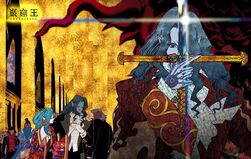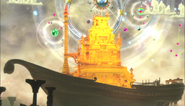Gankutsuou: The Count of Monte Cristo (巌窟王, Gankutsuō?) is a Japanese anime television series produced by Gonzo, based on the 1844 novel The Count of Monte Cristo by Alexandre Dumas. It was first broadcasted on TV Asahi on October 5th of 2004, and lasted 24 episodes; with the final episode being broadcasted on March 29th of 2005. it was licensed for a Western release first by Geneon Entertainment and later by Funimation.
The series is mainly told from the perspective of Viscount Albert de Morcerf, the teenage son of one of the Count's enemies. While the series adapts much of the original storyline and carries over its theme of revenge, the plot and characters feature multiple differences.
Geneon Entertainment acquired the North American release rights for Gankutsuou and released it under the title Gankutsuou: The Count of Monte Cristo. As of September 12, 2006, all six volumes have been released on DVD. A box set was also released as a compilation of the six DVDs. On December 27, 2008, Funimation announced that they had acquired the license and planned to release the series in 2009.
Plot[]
Set in the year 5053, the series focuses on the impact of the titular Count: formerly a sailor named Edmond Dantès, he was betrayed by his friends and imprisoned on false charges. Aided by a mysterious force dubbed "The King of the Cavern", Dantès escaped and refashioned himself as the Count, determined to exact vengeance on those who wronged him.
Episodes[]
Production[]

While the multiple layers of designs are chiefly remembered for their use as clothing textures, they had other uses as well: here the friends relax under a tree, their clothing and faces additionally patterned by the Chiaroscuroeffect of alternating bright sunlight and moving leaf shadows. The effect is even more striking in the moving image than in still images.
Among the artists referenced in the anime's style was Gustav Klimt, who was one of Maeda's favorite artists and provided inspiration for using blocks of strong primary colors and intricate patterns. Maeda combined multiple layers of complex design with the Ukiyo-e style common to all anime, a style of 19th century Japanese painting which strongly influenced the Impressionist movement. To create the anime's distinct animation style—which saw multiple bold colors and overlaid background and foreground texture layers—Maeda used a computer graphics program.

Use of the program came about due to issues created by the source material, which set its events in grand aristocratic houses, ornamented in the complex Art Nouveau or Baroque styles. Maeda also wanted to fully express the different textures of character clothing. This made key animation challenging; after trying several different animation types and getting nowhere, Maeda tried the computer-managed layering system, which made the process both possible and much easier than traditional animation. The illustrators only needed to create the clothing outlines for key frames rather than full character designs, for example. Because of this style, Maeda had to imagine each scene as being filmed with live-action actors rather than focusing on animation. By using the computer program, Maeda could create different texture layers within scenes. During the testing stages, Maeda worked with professional stylists, stapling fabric pieces to concept drawings to achieve the desired effect.

The computer animation gifted the production with the true blessing of moving images: patterns, spheres and cogwheels that could move, like an automated astronomical Orrery
The character designs were created by Matsubara, who had gained notoriety for his work on Oh My Goddess! and the Sakura Wars franchise. Matsubara was brought on at an early stage, when Maeda was putting together internal promotion videos for the project. Matsubara designed the characters based on Maeda's drafts. The character design of Gankutsuou was different from other anime of the time, not using shadows and highlighted elements and instead focusing on vigorous movement and exaggerated posture, communicating a character's personality through movement.
Custom Design[]
In addition to Japanese designers, Gankutsuou saw a collaboration with American fashion designer Anna Sui, who had previously done a collaboration for a Dark Horse Comics project and liked the prospect of working on a full-motion animation project, the studio's animation technology and Dumas's original novel. The anime uses clothing styles drawn from early 19th century France, showing fashions associated with the time including the "dandy" look and widening hems for women's skirts being incorporated. Sui described these designs as her biggest challenge.
Music[]
Voice Actors[]
Adaptations[]
Gallery[]




